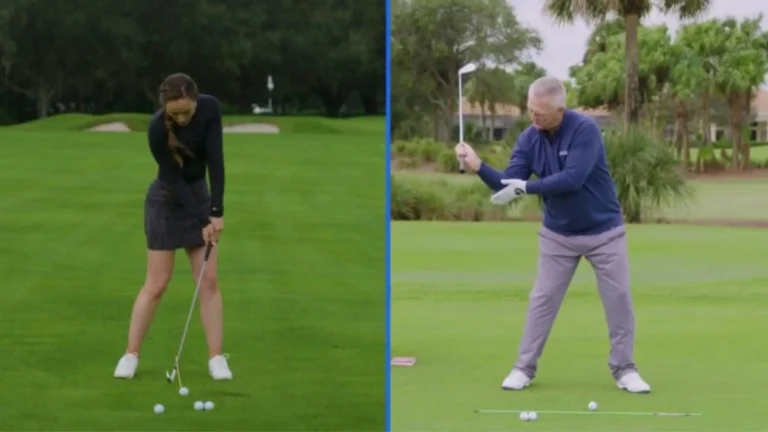The Importance of Understanding Golf Club Lofts
The position between the club face and the vertical plane at address is commonly referred to as the golf club loft. The loft angle influences ball flight, distance, and trajectory significantly. Choosing clubs with appropriate lofts and understanding how loft affects performance are critical components of improving your golf game. This article examines golf club lofts in depth, including loft charts for common club types, advice on selecting lofts for your game, and tips on adjusting lofts.
The Fundamentals of Golf Club Loft
Golf club loft is measured in degrees, with full swing clubs typically ranging from 0 to 64 degrees. At address, the higher the loft angle, the more vertical the club face sits. As the loft of the golf ball increases, it will launch higher with more backspin, resulting in a steeper landing angle. Lower lofted clubs, such as drivers, launch the ball lower and with less spin, resulting in more rollout and distance. It is critical to match the proper lofts to your swing speed and typical carry distance.
The Effect of Loft on Ball Flight Trajectories
The loft angle is the most influential club design feature on ball flight trajectory. The loft’s vertical launch angle and spin rate greatly influence the peak height and total carry distance of tee shots. In a distance-gapping strategy, using accurate lofts advances ball flight performance across the set from driver to wedges. Lofts are designed in collaboration with other club specifications such as lie angle and shaft flex to produce an incremental progression of shot results.
Charts of Golf Club Loft
Understanding standard golf club loft degrees for each club type is beneficial when assembling an appropriately gapped set. Keep in mind that lofts vary slightly between manufacturers, player types, and club release generations. The following are typical loft ranges:
Drivers – 8 to 12 degrees
Fairway Woods – 13 to 25 degrees
Hybrids – 16 to 27 degrees
Irons – 18 to 64 degrees
Wedges – 45 to 64 degrees
Putter – 3 to 4 degrees
Iron lofts have strengthened over the decades, meaning the angles have decreased. A modern pitching wedge may be the same loft as an 8-iron from 30 years ago. Be sure you understand the loft degrees of each iron when blending clubs.
Choosing Lofts Depending on Your Swing Speed
To maximize distance with proper trajectory gapping, clubs must be fitted to your swing characteristics. While club lofts have improved, golfers with swing speeds less than 85 mph still benefit from higher lofts. Using lofts that are appropriate for your speed avoids low-launching shots that reduce carry distance.
Lower lofts are required for faster swing speeds above 95 mph to avoid ballooning drives and steep drop-off angles. Custom club fitting considers factors such as speed and launch monitor metrics to determine the best lofts for your set. Understanding the proper lofts for your game can help you improve your consistency.
Changing Golf Clubs Loft Aspects
Manufacturers design clubs to industry standards, but customization allows for individual loft angle adjustments. Clubfitters bend the clubhead with special tools to change the lie angle, face angle, and loft for precise shot shaping. Loft adjustments may be required for a variety of reasons, including:
- Too low or too high a launch angle
- Club gapping is inconsistent.
- The maximum distance or height was not attained.
- Problems with consistent slice or hook
Due to construction methods, most modern drivers cannot be adjusted for loft angles. Fairway woods, hybrids, and irons have bendable hosels that allow them to be bent a few degrees higher or lower than standard specs. This fine tuning can result in improved gapping and control.
Because putters have little loft, aligned impact is more important than loft itself. Some players, however, benefit from a slight forward press or upward strike, which allows for small loft adjustments to help stabilize performance.
Advice on Golf Club Loft for Different Shots
In addition to total distance effects, club loft influences shot curve shape, peak trajectory, and backspin. Understanding how different lofts affect shots adds precision for specific targets or shapes. Here’s some loft advice for different shot types:
Drivers: Higher lofts provide more carry, while lower lofts provide more total distance. 11-13 degree drivers benefit senior players.
Fairway Wood: For par 5 reaches, keep gaps between woods to no more than 10-15 yards.
Long irons: Lofts of 18-22 degrees allow for long pure shots that run out rather than ballooning.
Mid irons: have lofts ranging from 24-32 degrees, which optimizes ball striking ability for consistent approaches.
Short irons with lofts ranging from 34 to 40 degrees provide excellent stopping trajectories on firm greens.
Wedges: Loft options in 4 or 5 degree increments allow for specialty shots around greens.
Putters: Low loft allows for direct face angle launch, keeping putts low and rolling end-over-end.
Understanding proper golf club loft angles goes hand in hand with gapping your set properly from beginning to end. Understanding the effects of loft on shot results aids in the diagnosis of equipment needs and the customization of club specifications based on playing ability for an incremental improvement in performance across the bag.
Conclusion
Golf club lofts must be properly matched to your swing speed and typical distances in order to maximize your capabilities. While club loft angles have increased over time and vary depending on player type, keeping gaps smooth from driver to wedges will improve ball striking consistency.
Professional club fitting analyzes launch conditions to fine-tune lofts in order to progress shot height and distance in the most efficient manner possible. Selecting clubs with the right loft degrees for your game, whether choosing between manufacturer loft offerings or pursuing custom bending, helps each club excel through optimized flight results.







